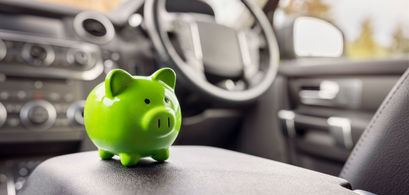Perhaps the most important term associated with a car lease is the money factor. It's the equivalent of the interest rate on a car loan, and provides the consumer with a measure of the financing cost associated with a lease. In this article, we're going to first run through the fundamental concepts of car leases. We'll explain how they're structured, how the dealership makes money, and outline several steps that everyone can use to figure out if the monthly lease payment being offered is a fair one. This is where the money factor comes into consideration. We'll even provide links to this website's online car lease calculators, as well as a spreadsheet that can be downloaded for free.
Car Leases and the Money Factor
Conceptually, a car lease isn't very different than buying a car and selling it at the end of the agreement's term. During the term of the lease, some of the car's value has been consumed. It's now worth less than when it was new. This lost value is a very important concept to understand because along with the money factor, the decrease in the car's value are the two most important variables affecting the consumer's cost to lease the car.
Calculating Monthly Payments
Most cars can be driven virtually forever, as long as the owner has enough money to pay for repairs. But as cars age, these repairs become more expensive and occur more frequently. When a car reaches this point, it is said to be at the end of its useful, or serviceable, life. All of the value has been extracted from the vehicle. This is the concept behind depreciation.
Depreciation Expense
When a dealership calculates the monthly lease payments, they need to determine the depreciation in value the car will experience. They need to be able to accurately predict how much the car is worth at the end of the lease.
The money factor when leasing a car is equivalent to the interest rate on a loan when buying a carMoneyzine Editor
Since most leases are relatively short in duration, 24 to 48 months, one of the best predictors of depreciation is the age of the vehicle and the number of miles it has been driven. This is the reason the leasing agreement specifies an annual mileage cap; to help control the car's depreciation in value.
To calculate the depreciation cost of your car, use our free depreciation calculator.
Cost of Borrowing Money
When a car is leased, the dealership still owns the vehicle. Since they're allowing the lessee to take possession of a $30,000 asset, and pay for it via monthly payments, they're assuming a risk of non-payment. They're also losing an opportunity cost: They could be investing the money they used to pay for the car elsewhere.
Money Factor Calculation
This is where the concept of the monthly finance fee, or money factor, comes into play. The money factor compensates the dealership, or lender, for both the risk of non-payment as well as the lost opportunity cost. In fact, the money factor is directly comparable to the Annual Percentage Rate, or APR, consumers use to compare car loans. The two simple formulas below demonstrate the relationship between the money factor and interest rates:
Interest Rate = Money Factor x 2400
Money Factor = Interest Rate / 2400
Car Lease Example
To better understand how depreciation and money factor affect monthly car lease payments, let's run through a quick example: Let's assume Haley is going to lease an Audi A4 with a MSRP of $37,000. Furthermore, let's also assume that she is able to negotiate a Base Capitalized Cost (Base Cap Cost) of $30,000. To calculate how much "money" is involved with this lease, it's necessary to add in dealer acquisition fees (around $750) and any extended warranties ($2,000 in this example). This results in a total of $32,750 in Gross Capitalized Costs. Next up, it's possible to lower the amount of capital (money) involved by trading in a car for $3,000, and providing a down payment of $3,200. The net capitalized cost is now only $26,550 ($32,750 - $3,000 - $3,200). Finally, let's also assume the car's residual value is $16,000 after three years. If we ignore sales tax, the lease payment would be the sum of the depreciation plus the finance, or rent charge. Depreciation is the difference between the net capitalized cost and the residual value, which is $10,550 in this example.
Rent or Finance Charge
The rent or finance charges are the "cost" to lend the lessee money. We already know how much must be paid for the car's lost value ($10,550), and this is where the money factor comes into play. The rent or finance charge is calculated using the following formula: Rent or Finance Charge = (Net Cap Cost + Residual Value) x Money Factor x Lease Term Going back to the example, if we assume the money factor is equal to 0.00292 (which is equivalent to an APR of 0.00292 x 2400 = 7.0%); the total finance charge is $4,472.86. If this is added to the depreciation cost, then the lessor needs to collect $15,022.86 over 36 months. This works out to be $417.30 per month.
Getting a Good Deal
From the above example, it's clear that it's not easy to figure out if a car lease is a good deal. It's possible to simplify the steps involved in this calculation by assuming the residual value is a fair price. After all, the lessee usually has the option of purchasing the car for its residual value at the end of the lease, so the dealership likes to keep that number as accurate as possible. Consumers that are good at negotiating will also have a pretty good idea of what's a fair price to pay for the car, which is its base capitalized cost. Knowing these two data points allows for the calculation of the depreciation charge. There is only one other piece of information needed to make sure the deal is a fair one: the finance or rent charge, which is the money factor.
Car Lease Calculations
Unless the consumer is great with numbers, they're going to have to ask the dealership for the money factor, or it can be calculated using the finance charge appearing on the agreement. The easiest way to figure out the factor is simply asking the dealership for the number, and multiplying that value by 2400. When stating the money factor, dealerships may quote a value like 2.92 instead of 0.00292. If they quote the money factor this way, then just multiply the value by 2.4 to derive the interest rate charged. Once the interest rate is known, it's possible to determine if the rate is competitive based on prevailing rates and the borrower's credit rating.
Online Calculators
This website has a large number of car loan calculators that can be used to perform more detailed calculations. We also have a lease or buy a car calculator that allows users to compare these two options. Finally, anyone that's interested in learning more about money factors should read our article on car lease calculators. This article contains a spreadsheet that can be downloaded for free, along with a complete set of instructions.

